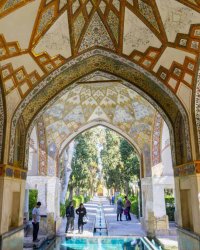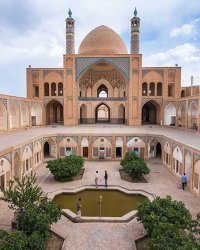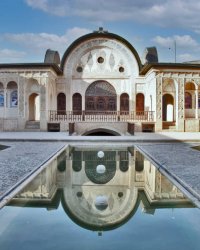Kashan is the ancient oasis of the central plateau. Its history, thanks to the archaeological mounds of Sialk, dates back to time immemorial.
Its name recalls the tiles in Persian, but the city is famous for its rose gardens, and of course the distillation of rose water, with its annual festival.
In the 19th century, its hand-woven rugs exported the Kashan’s fame artistic through the world.
The city has suffered from so many climate changes and the loss of the carpet market, the basis of its industry, over the past decades.
Due to this economic and geographic desertification, the city experienced waves of migration to other major metropolitans like Tehran and Isfahan, but the city has been able to react thanks to the resumption of tourism.
Hundreds of old houses transformed into boutique hotels welcoming their guests.
The fact that the city is located on the north-south axis, makes it an ideal overnight stopover and fits well in tourist trip plans.
The Fin garden offers the visit of a typical Persian garden, with its vegetation and its architecture.
The sad tragedy of the murder of Grand Vizier Amir-Kabir, one of the heroes of Iranian history, took place in the depth of his bath.
Take the time to climb on the roof of the Seraglio of Amin-o-doleh in the bazaar where you can admire the sunset.
Can you leave Iran without visiting Kashan?
Located on the edge of Kavir desert, with hot summers and cold winters, and a population of only 329,000, Kashan may noy seem to you as a must-see attraction at first glance. However, this seemingly unimportant town has always been comparable to the biggest cities of Iran during its history. Let us have a look at Kashan’s history to see why you should take a Kashan City Tour.
Four kilometers to the west of Kashan, there lies a mound, or better to say a series of mounds, generally referred to as Tappeh Sialk. Many archeologists believe that these mounds hold the relics of the ancient city of Sialk, a town inhabited by a civilized people from the 4th millennium BC or even earlier, which makes Kashan one of the most ancient sites of civilization on the Iranian plateau.
Furthermore, the presence of a fire temple and a Mithraic cave, called Rais Cave, in the nearby town of Niāsar are confessions to the importance of the region during the pre-Islamic Sassanid era (224 to 651 AD).
No wonder, this long, long history has given birth to many exotic stories, breathing a mythic spirit into the old alleys of Kashan. One such story claims “the three Wise Men,” those well-known ones who attended the birth of Christ, departed from Kashan to Bethlehem to meet the newly born son of God.
Or, take the odd story of the Arab conquest of the city in the 7th century. According to legend, as the troop of Islam, led by Abu Musa al-Ash’ari, arrived at the gates of Kashan city, they found the fortifications of the city insurmountable. Finally, after rounds of heated discussion, the generals came to the conclusion that they had to throw scorpions into the city to bring people of Kashan to their knees. And that’s how various historians during history have accounted for the abundance of scorpions in Kashan, a city which was once famous for its deadly scorpions. But DO NOT PANIC! There is no trace of those scorpions in the city any more.
By the way, after Islam, Kashan came under the jurisprudence of Isfahan governors. Yet, this didn’t prevent various tribes from attacking the city until Zobeida, the favorite wife of the Caliph Harun al-Rashid, ordered the construction of new fortifications around the city. Sad to say, these structures were ruined by two earthquakes in 854 and 857 AC.
However, Kashan began to transform from an agricultural township into an urban center under the Buyid rule (9th century). Although Buyids did their best to rebuild the city, Kashan was hit by another devastating earthquake in 957 AC. Adding fuel to fire, a violent epidemic which followed next year practically eliminated the city.
Despite all these unfortunate events, the process of rebuilding the city continued well into the second half of 11th century, when Kashan gained importance as a military gateway to Isfahan and a Saljuk capital. During the Saljuk rule (12th century), the old congregational mosque of the city from the Buyid period (known today as Masjed-e Jameh or Masjed-e Kohneh), and also canals and dykes for the management of water were renovated. In addition, a city wall with eight towers and two gates were built around the city (today, you can visit the remains of this city wall, plus a fortress, known as Jalali Castle, and two ice houses, at the end of Alavi Street). By 1500, Kashan was the most important town in the region after Isfahan.
Years later, the coronation of King Ismail I in Fin Garden invested Kashan with a quasi-holy aura which absorbed the respect and attention of almost all the Safavid kings. Furthermore, Shah Tahmāsb, the second Safavid king, invited an influential theologian, Mohaqqeq Korki, to come and reside in the city. This move turned Kashan into an important religious city, winning it the title of Dar al-Momenin or the House of the Faithful. And it is one of the reasons that Shah Abbas I, the greatest Safavid king, was buried in Habib Ibn Musa Shrine in this city.
The Safavid period was the period when the production of handicrafts in Kashan reached its peak. At this time, Kashan’s workshops produced the best quality carpets, velvets, glazed pottery and tiles in the country. It is interesting to know that the name of tile in Farsi, Kāshi, comes from the name of Kashan.
At the beginning of Qajar period, Agha Mohammad Khan, the founder of Qajar dynasty, razed part of the city and killed many of its citizens. But, after a while, the peace came back to the city and it began to prosper once more.
Kashan was once well-known for its carpets and tiles, but nowadays many people rush to visit this city because of its exemplary traditional Iranian houses. With a special architectural structure unique to desert houses known as Gowdal Baghche, fine stucco, colorful sash-windows, amazing mirror-work and vivacious paintings, these houses provide you with the best examples of private residences in Iran during the Qajar period. We can mention Tabatabaei House, Boroujerdi House and Abbasian House as most famous of them, located in Sultan Mir Ahmad Neighborhood, one of the oldest neighborhoods in Kashan in Alavi Street.
While still in Sultan Mir Ahmad Neighborhood, you can also visit Sultan Mir Ahmad Shrine which lends its name to the whole neighborhood. Then, you can go to have a look at Sultan Mir Ahmad bath, a 500-year-old Iranian hammam. The rooftop of Sultan Mir Ahmad Bath provides you with a panoramic view of Kashan and the best place to take fantastic photos for your Instagram.
Also, you shouldn’t miss the historic bazaar of Kashan, a trade center for about 800 years. The bazaar is busy but not hectic, lined with old-fashioned shops filled with goods that you can only find in a traditional bazaar. Do not forget to spend some time in Saray-e Amin al-Dowleh, which its unique architecture and cozy atmosphere would mesmerize you.
Masjed-e Soltani and Masjed-e Mir Ahmad are among the notable mosques you can visit in Kashan. But we strongly suggest visiting Aqa Bozorg Mosque whose two-storey structure, simple yet awe-inspiring brickwork and delicate inscriptions make this Qajarid mosque one of the most visited sights in Iran.
Finally, to relax after a long day in Kashan, we invite you to visit the grand Fin Garden. Its marvelous Safavid pavilion, surround by tall cedar trees, turquoise-colored ponds and water streams and also other smaller pavilions from the Zand and Qajar eras, with paintings narrating old Iranian tales, turn this garden into a World Heritage Site the epitome of the world-known Persian gardens. And if you are interested in historical stories of political betrayal and murder, dedicate some time to exploring the bath of Fin Garden. There, the veins of Amir Kabir, the grand prime minister of Naser al-Din Shah and one of the greatest political activists who radically changed the face of Iran, were split. He bled to death in the bath of Fin Garden, as a result of a conspiracy against him, led by Mahd-e Oliya, the mother of the king, and all the princes and princesses who could not tolerate the fundamental changes that Amir Kabir imposed on their lifestyle.
However, Kashan in not just history, art and architecture. If you attend Kashan in spring, you would be able to participate in the festival of Golab-giri, a ceremony in which rose flowers are collected, boiled and turned into a fragrant liquid, known as Golab, used as perfume or in cooking different foods and sweets.
Finally, whenever you feel hungry, you can try any of these local dishes of Kashan: Jujui Tas Kabab, Kateh Moatar, Khoresht Nokhod Alleh, Sumac Kufta, Chickpeas Kufta, Eggplant Kufta, Meat and Beans, and Quince Stew.
So, if you are curious to visit this ancient city of culture, art, architecture, nature and mouth-watering dishes, do not hesitate to book your Kashan City Tour with us at Irandelle Travel Agency.



